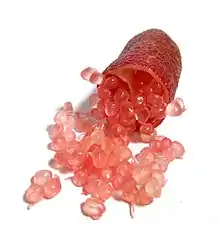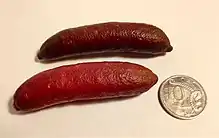Citrus australasica
Citrus australasica, the Australian finger lime or caviar lime, is a thorny understorey shrub or small tree of lowland subtropical rainforest and rainforest in the coastal border region of Queensland and New South Wales, Australia.
| Australian finger lime | |
|---|---|
 | |
| Green skin type finger lime | |
| Scientific classification | |
| Kingdom: | Plantae |
| Clade: | Tracheophytes |
| Clade: | Angiosperms |
| Clade: | Eudicots |
| Clade: | Rosids |
| Order: | Sapindales |
| Family: | Rutaceae |
| Genus: | Citrus |
| Species: | C. australasica |
| Binomial name | |
| Citrus australasica | |
| Synonyms[1] | |
| |
It has edible fruits which are under development as a commercial crop.[2][3]
According to the Swingle system it is not part of the genus Citrus, but in a related genus Microcitrus.[1]
Description
The plant is 2–7 m (6 ft 7 in–23 ft 0 in) in height. Leaves are small, 1–6 cm (0.39–2.36 in) long and 3–25 mm (0.12–0.98 in) wide, glabrous, with a notched tip and crenate towards the apex. Flowers are white with petals 6–9 mm (0.24–0.35 in) long. The fruit is cylindrical, 4–8 cm (1.6–3.1 in) long, sometimes slightly curved, coming in different colours, including pink and green.[2]
Cultivation and uses
History
Early settlers consumed the fruit[4] and retained the trees when clearing for agriculture. Colonial botanists suggested that they should be cultivated.[4]
Rising demand

The finger lime has been recently popularised as a gourmet bushfood. The globular juice vesicles (also known as pearls) have been likened to a "lime caviar",[5][6] which can be used as a garnish or added to various recipes. The fresh vesicles have the effect of a burst of effervescent tangy flavour as they are chewed. The fruit juice is acidic and similar to that of a lime. Marmalade and pickles are also made from finger lime. Finger lime peel can be dried and used as a flavouring spice.[2]
Commercial use of finger lime fruit started in the mid-1990s with boutique marmalades made from wild harvested fruit. By 2000 the finger lime was being sold in restaurants, and exported fresh.[2]
The finger lime has been recently grown on a commercial basis in Australia in response to high demand for the fruit. There is an increasing range of genetic selections which are budded onto citrus rootstock. With the sudden high market demand for the fruit the primary source of genetic material for propagation has been selections from wild stock.
Diseases

In cultivation, the finger lime plant is grown in much the same way as other citrus species. It may be subject to some pests and diseases requiring pest control in cropping situations. This includes scale, caterpillars, gall-wasp, and limb dieback. Research into fruit fly has concluded that finger limes are a non-host plant to fruit flies and as such are not a quarantine risk to importing countries.
Research conducted since the 1970s indicated that a wild selection of C. australasica was highly resistant to Phytophthora citrophthora root disease, which has resulted in a cross-breeding program with finger lime to develop disease-resistant citrus rootstock. In 2020, researchers began working with C. australasica to develop solutions for Citrus greening disease.[4][7]
The CSIRO has also developed several Citrus hybrids by crossing the finger lime with standard Citrus species. These hybrids have created many cultivars which generate finger limes in many different colors ranging from light pink to deep blue-green. Finger lime is thought to have the widest range of color variation within any Citrus species. The color of the pulp (juice vesicles) comes in shades of green or pink including pale lime-green, pale pink, coral, and scarlet.
Taxonomy
| Australian limes |
| |||||||||||||||||||||||||||||||||
References
- "Citrus australasica F.Muell. — The Plant List". www.theplantlist.org.
- "Citrus pages, Native Australian Citrus, Citrus australasica". users.kymp.net.
- Mueller, Ferdinand von (April 2, 1858). Fragmenta phytographiæ Australiæ /. v.1 1858-59. Auctoritate Gubern. Coloniæ Victoriæ, Ex Officina Joannis Ferres.
- Low, Tim, Wild Food Plants of Australia, ISBN 0207143838
- Karp, David (23 December 2009). "Finger lime: the caviar of citrus". Los Angeles Times – via LA Times.
- Star, Tamborine Mountain Daily. "Nature's 'Little Pearls', The Exotic Finger Lime". www.tamborine-daily-star.com. Retrieved 2018-06-25.
- Allen, Greg (July 27, 2020). "Exotic Australian Fruit May Help Save Florida's Citrus Industry". NPR. Retrieved 28 July 2020.
- Jorma Koskinen and Sylvain Jousse. "Citrus Pages / Native Australian varieties". free.fr.
External links
 Media related to Citrus australasica at Wikimedia Commons
Media related to Citrus australasica at Wikimedia Commons- "Citrus australasica". Australian Plant Name Index (APNI), IBIS database. Centre for Plant Biodiversity Research, Australian Government. Retrieved 9 January 2014.
- "Citrus australasica F.Muell". Atlas of Living Australia.